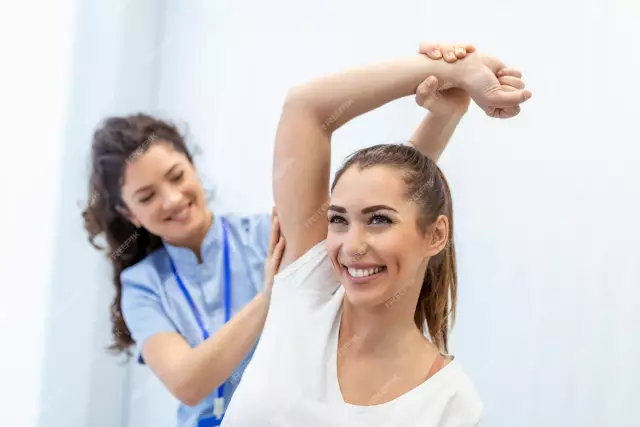- Author Rachel Wainwright [email protected].
- Public 2023-12-15 07:39.
- Last modified 2025-11-02 20:14.
Stretching
Stretching (or "stretching") is a system of physical exercises aimed at stretching certain muscle groups, ligaments, tendons. The name comes from the English word "stretching", which means "stretching", and fully reflects the essence and main purpose of the complex.

Streching began to be singled out as a separate direction relatively recently - in the middle of the last century, and it received official recognition and justification in the works of scientists only twenty years later.
The stretching training system is used as an independent direction, and individual exercises are included in almost all training and health complexes.
Types of stretching
There are several systems for classifying stretching exercises.
According to the degree of impact on the muscles, stretching is divided into soft and deep.
When doing gentle stretching, the muscles are stretched to their normal length. The average exercise time is approximately 30 seconds.
The purpose of deep stretching is to stretch the muscle to a new length. At the same time, each exercise can take from 2 to 5 minutes.
Depending on the methods of performing the exercises, static, passive, dynamic, active, ballistic, isometric, proprioceptive neuromuscular stretching are distinguished.
Static stretching is characterized by a smooth and slow (up to several minutes) execution of each exercise. Stretching occurs under the influence of your own body weight. At the same time, stretching is not based on muscle tension, but on its relaxation. This type of stretching workout has a beneficial effect on the muscles, gently works the joints and stretches the tendons. Static stretching is recommended for people with minimal or no physical fitness.
Active stretching is aimed at working with a certain isolated muscle, which at the same time may be in a passive state, while stretching itself occurs due to the load on the surrounding muscle groups. Active stretching not only helps to stretch muscles and tendons, but also to increase joint mobility.
Dynamic stretching is also fairly safe. It is based on stretching muscles through a change of tension by relaxation. Dynamic stretching in comparison with static stretching is considered more effective, since the exercise is performed with a gradual increase in the range of motion.
Ballistic stretching is considered to be the most unsafe type, since it is based on sudden movements performed with a large amplitude and significant speed. The main exercises are flexion and extension of the trunk and swinging movements of the arms and legs.
Dynamic and ballistic stretching can only be done under the supervision of an experienced trainer.
Isometric stretching. In this case, the stretching process is carried out due to muscle tension and is carried out in four stages: tension - relaxation - stretching - fixation. This type of stretching is the most effective, but requires special efforts and sufficient physical training.
Proprioceptive neuromuscular stretching ("proprioception" - deep sensitivity). This type of stretching is similar to isometric, but involves the participation of another person in the tension phase. Very often this other person is the trainer of the rehabilitation center, since this type of stretching is practiced for therapeutic purposes. Exercise helps restore the mobility of individual joints and limbs in general, impaired as a result of injury, illness or surgery.
The healing effect of stretching workouts
- Joints become more mobile, elasticity and flexibility of muscles increase.
- Posture improves.
- Cellulite deposits are reduced.
- Stretching relieves pain associated with permanent nervous tension or pinched nerve roots.
- The alternation of tension and relaxation has a beneficial effect on the nervous system, helping to eliminate the consequences of stress.
- Blood circulation is accelerated, which provides additional oxygen supply to all muscles of the body, including the heart.
- The lymph flow is enhanced, stagnation in the lymphatic system is eliminated.
Contraindications and limitations to stretching
Despite all the benefits and availability of stretching workouts, there are contraindications to them, as well as to any type of physical activity:
- recent fractures;
- chronic joint diseases during an exacerbation. As soon as remission occurs, exercise is not only not contraindicated, but even useful;
- hernia;
- severe curvature and instability of the spine;
- recently transferred dislocations. If you stretch in a state of injured ligaments, a recent dislocation can turn into a habitual one;
- atherosclerosis, thrombosis, thrombophlebitis and other diseases of the cardiovascular system associated with increased thrombosis. For the same reason, you should be wary of stretching training for varicose veins;
- with hypertension, complexes involving bending are contraindicated;
- spinal osteochondrosis is a contraindication for twisting exercises. All other stretching exercises, on the contrary, by stretching the muscles of the thighs, pelvis, shoulder girdle and strengthening the back and press, will relieve the condition;
- vigorous stretching workouts are not recommended after intense strength training. After a serious strength load on the joints, only light stretching exercises are permissible to relax the muscles.
Rules for doing stretching exercises
Warm up before stretching to improve blood circulation and oxygen supply to the muscles.
Avoid jerky movements while exercising.
Correct performance of stretching exercises is not accompanied by pain. You should feel the muscles, not the pain in them.

Stretching should begin with the larger muscles to increase blood flow to the smaller, more vulnerable muscles.
Concentrate on the muscle that you are stretching at the moment, without being distracted by anything else.
The pause in the maximally stretched position should be about 10 - 30 seconds. If, after this time, the tension does not subside, then the stretching was too strong. Stop the exercise and start over.
Breathe deeply as it relaxes your muscles and helps you stretch. Begin all inclines with exhalation, and stretch with inhalation.
When doing any of the stretching exercises, take a stable position.
Pay special attention to stretching the muscles that you load more and more often. For example, if you are fond of jogging, you should focus on the quads and hip flexors.
Act gently and gradually, build up the amplitude of the stretching exercises in small portions.
Stretching workouts are often referred to as "feline fitness". Be patient and stretch regularly, and you will achieve feline flexibility and grace.
Found a mistake in the text? Select it and press Ctrl + Enter.






